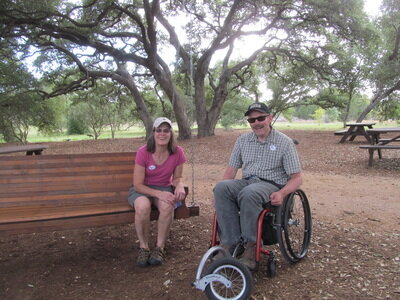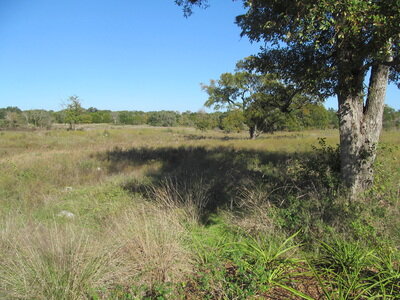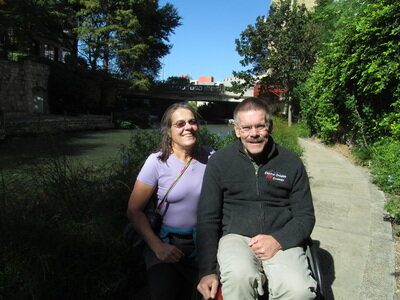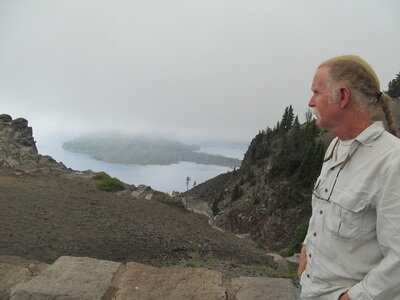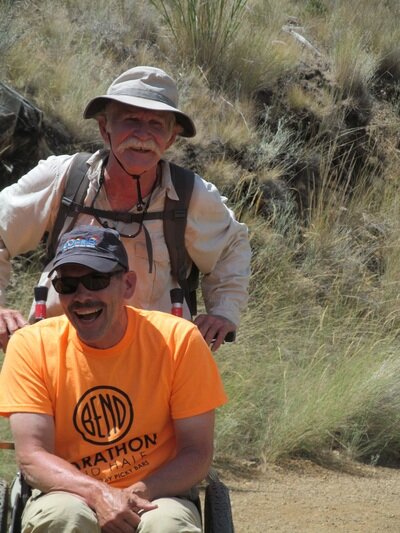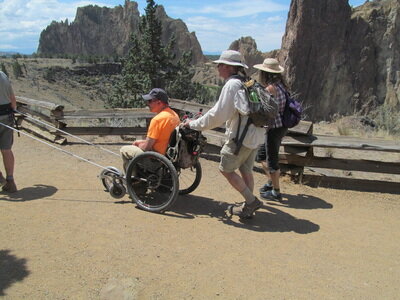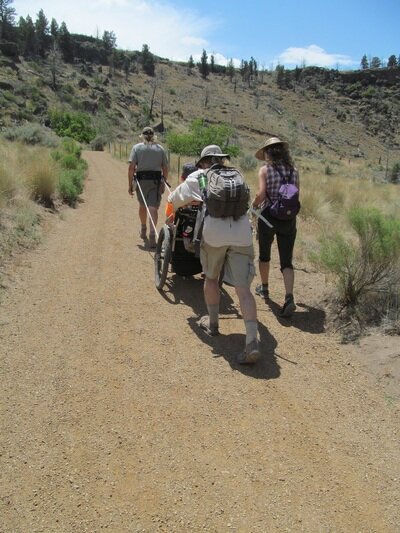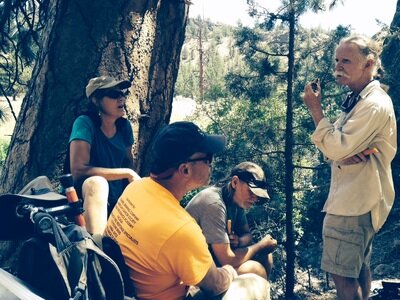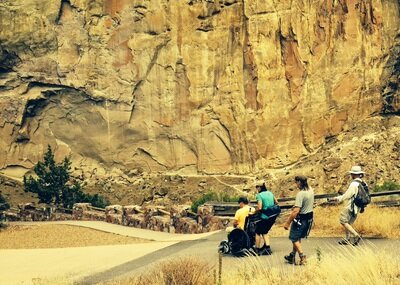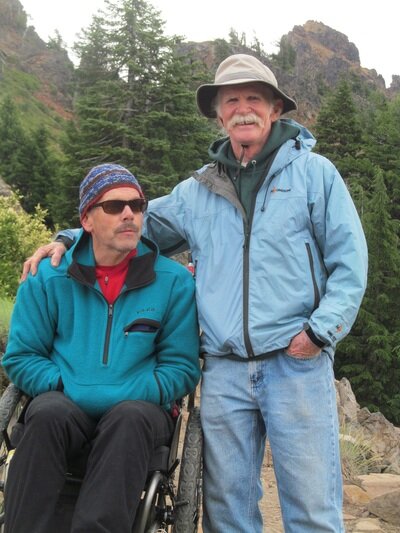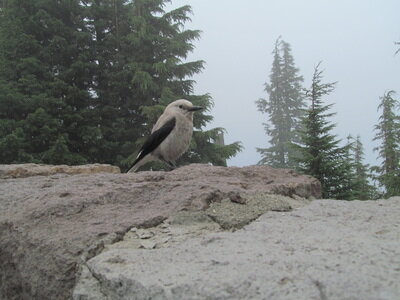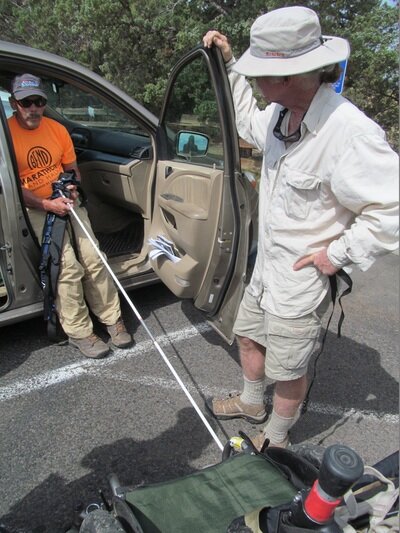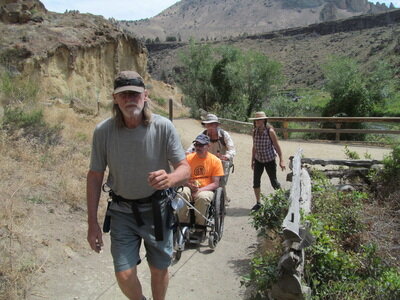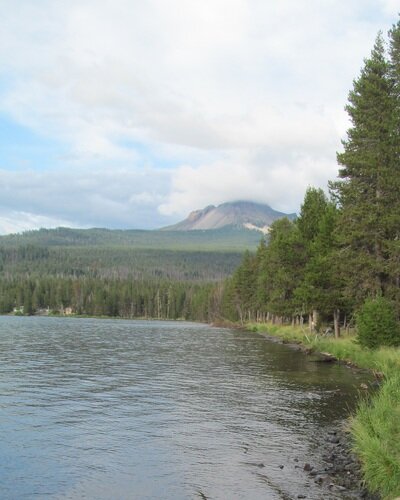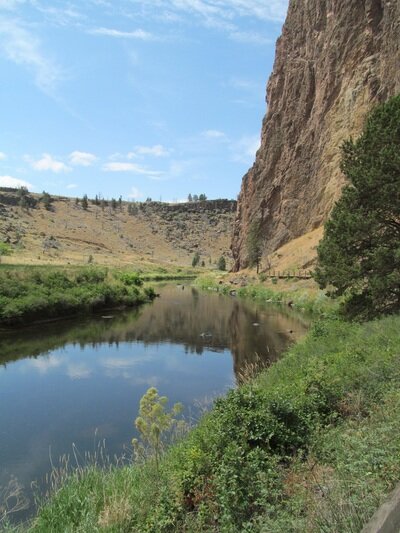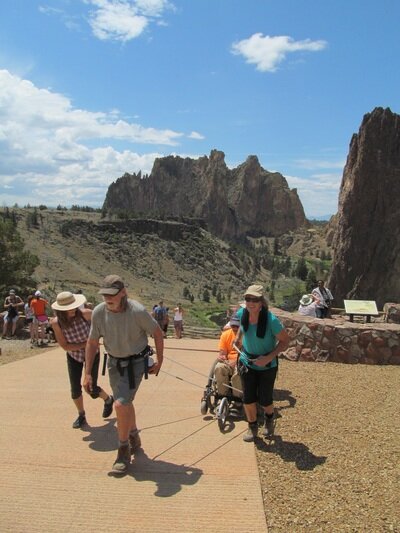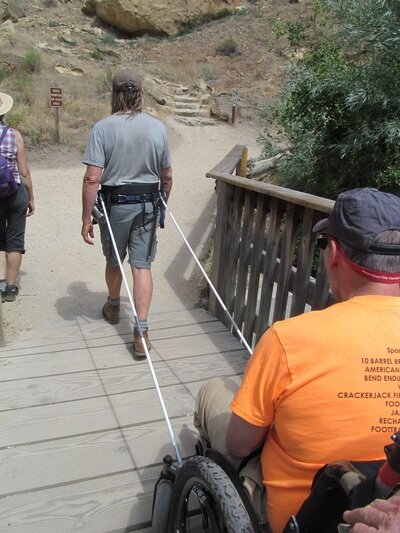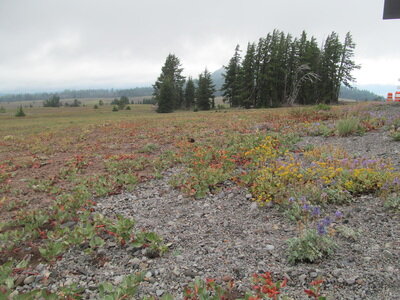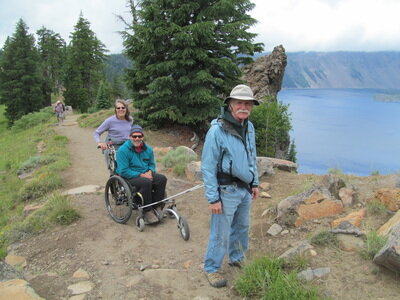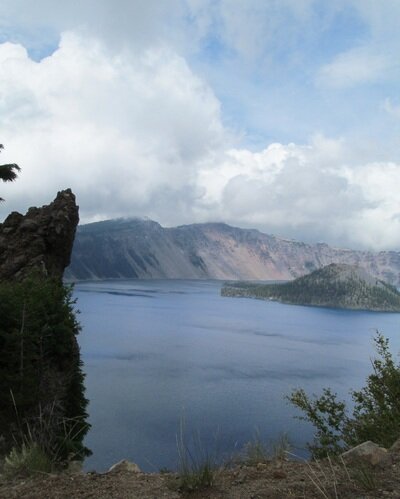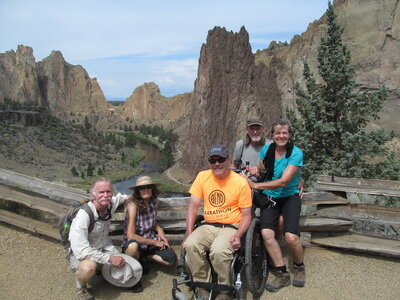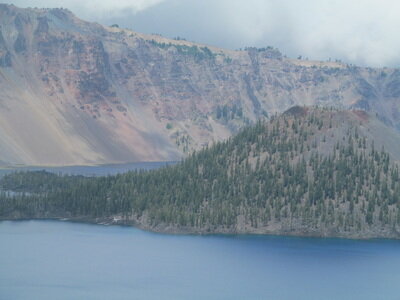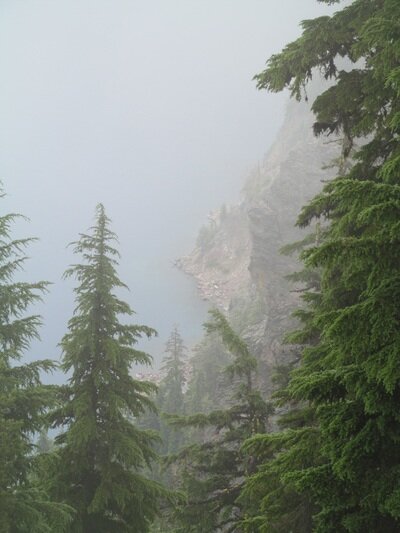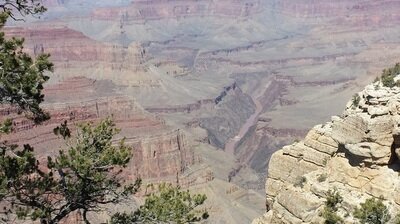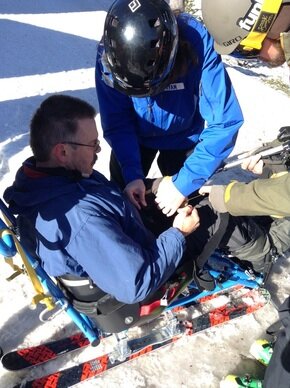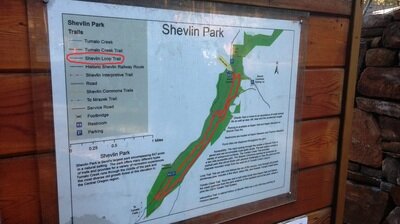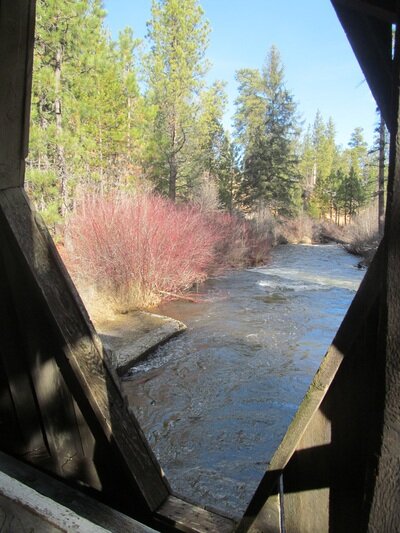Field Notes
See the pictures, read on for the stories.
The latest Instagram pictures rotate through, along with links to their quick stories. But there’s so much more to tell. Some from our own experiences, others that are shared. From young to old, from local to international, the AdvenChair is making the rounds!
“The wild requires that we learn the terrain, nod to all the plants and animals and birds, ford the streams and cross the ridges, and tell a good story when we get home.”
—Gary Snyder
And the stories we can tell!
We love to share our news and yours. Have an AdvenChair story to tell?
Calm Amidst the (Fire) Storm
A lone clarinet player sat under the Augusta Street Bridge as we completed our last stroll on the River Walk. We had been in San Antonio for the Association for Fire Ecology’s 6th International Fire Congress and the quiet jazz melody lilting over the river was a calming send off from a very busy, energetic, and enjoyable week.
A lone clarinet player sat under the Augusta Street Bridge as we completed our last stroll on the River Walk. We had been in San Antonio for the Association for Fire Ecology’s 6th International Fire Congress and the quiet jazz melody lilting over the river was a calming send off from a very busy, energetic, and enjoyable week. I had worked for the past two years with the conference steering committee to pull this off and even last minute uncertainty about U.S. Forest Service participation couldn’t prevent a successful event attended by over 600. With a huge amount of behind the scenes work, especially by our hard-working co-directors, AFE has been organizing high quality events like this that bring together fire researchers, managers, and students for 15 years.
Conferences are also important for keeping the “Fire Family” together. It’s really gratifying to see friends I’ve known since 1988, as well as colleagues from around the country and world (Spain and Mexico). Even the workshop on fire effects I organized included students from Ghana and The Netherlands.
I couldn’t attend conferences without help and am always grateful that Yvonne can travel as my caregiver. After the meetings were over on Friday we took our own field trip to the Lady Bird Johnson Wildflower Center near Austin and decompressed from a busy week. Yvonne is very much a part of the Fire Family, helping with registration, taking in presentations, and even managing to get away from the conference and fit in a day of birding with an old friend.
Downtown San Antonio is built around the River Walk, a section of the San Antonio River that was channelized in the early 1900’s for flood control, and later developed into an entertainment district. While narrower than the irrigation canals here in Central Oregon and moving slower than a “lazy river” at a water park, the Paseo del Rio reminded me of EPCOT at Disney World with all the colors, smells, and music of all the restaurants and hotels. Once we figured out where the elevators and ramps were to access the river walk with my wheelchair from the streets above, we rapidly learned why this was such a popular destination.
The memory of the peaceful musician was important to us mere hours later at the San Antonio airport after learning that we would miss our Denver to Redmond flight to get home that evening. Jazz helped us see the brighter side of spending another night in San Antonio - compliments of United Airlines.
Despite the short drive to La Quinta our cab driver was impatient with us, possibly because he wanted to get back into the queue at the airport to collect fares greater than the measly $12 that our trip provided. We shook our heads as he drove off, but felt compassion for him as we tried to imagine the struggles he faced and the battles he was fighting that we knew nothing about.
After dropping our luggage in our room we navigated extremely busy streets and narrow sidewalks to use our United food vouchers at Applebee’s (what a step down after a week of great food), crossing over and under an incredible interchange of 12 lanes. While pop dance music blared in the restaurant I closed my eyes and smiled, thanking the clarinet player under the bridge for the image of solitude that we needed six hours later.
After a few hours of fitful sleep the taxi picked us up at 4:30 a.m. to take us back to the airport. Once we were finally headed north the flights were smooth and uneventful and clear skies, the snow-covered peaks of the Three Sisters, and Casper the Talking Dog welcomed us home.
Born Again - A Worldview Re-imagined by a Brain-Stem Stroke
Bruce Cockburn was on my mind as I watched the sunrise from my hospital bed. I was on day five of my two week meditative retreat in early October that was the result of a “bad” urinary tract infection that was “everywhere”, and I had survived into another day.
“Sun’s up, uh huh, looks ok. The world survives into another day…”
Bruce Cockburn was on my mind as I watched the sunrise from my hospital bed. I was on day five of my two week meditative retreat in early October that was the result of a “bad” urinary tract infection that was “everywhere”, and I had survived into another day. I called it a “retreat” because once the doctors told me what was causing my 103.5 degree fever I knew that I would need a Zen-like approach to overcome it. No TV. No cell phone. Just being present with my body.
The first couple of days my mantra was “gather and purge” as I focused my thoughts on collecting the infection and expelling it. After a very long night of cold sweats and spasms the doctor ordered a change in treatment that finally brought some comfort. I devoured an omelet for lunch, my first solid food in four days and slept soundly through the afternoon.
The mantra for the next three days was “rest and heal”, followed by the “strengthen” phase of seven days in rehab to get me ready to go home.
The irony (or not) of this hospital visit is that it was just a month short of my “Tenth Second Birthday”, the time I celebrate surviving my brain-stem stroke on November 10, 2005. This time was different though. I smiled through my pain as I patted the CT scanner with my knuckles, celebrating a “win” over the machine simply because I held my breath for five seconds of the scan. In my first encounter a decade ago I couldn’t hold my breath for more than a few seconds, one of several things that scared me on my last long night in the hospital.
This time though, not only did I know the hospital routine, knew a lot of staff, which really made for a light, comfortable, and healing environment. Mostly we just picked up the storyline from where we left it off years ago and I don’t know how many times I heard “I’m sorry you’re here, but it sure is nice to see you”. I think I gave them as much energy as they gave me. My doctor even arranged for me to have the best room in the rehab unit.
I was reminded of how grateful I am to have survived the “neurological insult” of my brain-stem stroke that so few people do. This was made obvious when I rolled up to the table for my first meal in the rehab dining room. Of the six men sitting there (all of us in wheelchairs), only two could talk, all affected by strokes or traumatic brain injuries. I was in the non-speaking group my last time there.
My week-long stay in rehab consisted of three hours of therapy a day and brought my energy and strength almost back up to pre-infection levels. I checked out of the hospital in time to have lunch with Yvonne and attend my Leadership Bend class that afternoon. Two days later, to celebrate my “first” birthday, I enjoyed a seven mile “advenchair” with family and friends on the Deschutes River Trail – followed by lots of sleep!
So November 10th is always big for me and my family. We celebrate the day “life shoved us through an unexpected door” and put us all on a new path full of adventures and rich experiences.
“I had another dream about lions at the door, but they weren’t half as frightening as they were before….” ---- Wondering Where the Lions Are, Bruce Cockburn
The Downsides to the Upsides of a Stroke
As many of you know, Geoff caught a nasty little infection from which he is still recovering. Friday (Sept. 25th) he came down with the chills and by Saturday was struggling to make transfers even with Dennis and Yvonne's help.
As many of you know, Geoff caught a nasty little infection from which he is still recovering. Friday (Sept. 25th) he came down with the chills and by Saturday was struggling to make transfers even with Dennis and Yvonne's help.
Once checked into the emergency room, the doctors made a rapid diagnosis and started treatment immediately. Of course, that still meant a week of cold sweats and hospital food, but on Thursday (Oct. 1st) he transferred down to rehab. A decade later, many of his previous nurses and therapists are still at St. Charles and this adventure brought many of them back into Geoff's room (a blog with some of these stories sure to come later).
Anyway, I am told that he hopes to return home this coming Thursday (Oct. 8th) so go visit him now for the gown pics!
Just kidding... clearly he is back in real clothes.
A Wizard, A Weasel, and a Badass Wheelchair
“Sticky” Steve Morrison was up from Florida and we were eager to show him some of our Oregon beauty. Shepard Smith and Kirsten Nugent had brought Sticky to Bend from Corvallis and had wanted to see Smith Rock State Park (“to see the old homestead”) Friday before heading back to the Willamette Valley.
“Sticky” Steve Morrison was up from Florida and we were eager to show him some of our Oregon beauty. Shepard Smith and Kirsten Nugent had brought Sticky to Bend from Corvallis and had wanted to see Smith Rock State Park (“to see the old homestead”) Friday before heading back to the Willamette Valley. That was the chance we had been looking for to take the AdvenChair, now outfitted with disc brakes and a towing system, down and back up the steep trail to the Crooked River.
The brakes held me perfectly as Yvonne piloted me down the hill (Sticky and Shep followed holding webbing as a redundant system should Yvonne slip). Safely at the river, we took the wide path downstream until we found a good lunch spot. Then came the real test; could we get back up the hill? Sure enough, with Shep, Yvonne, and Kirsten pulling and Sticky pushing, the team grunted me (with a couple of rest stops) to the top, aided by the 50 yards of concrete walkway poured over the steepest crux pitch. We were ecstatic about the hike and bought ice cream in Terrebonne to celebrate!
Sticky (he’s a bee keeper) had flown into Medford so we volunteered to drive him back Saturday and to take him to Crater Lake National Park. We crested the hill to the rim, pulled into the first viewing spot, and looked down upon Crater Lake. It was brisk and windy and the gray swirling clouds prevented us from seeing the shoreline hundreds of feet below, much less the east side of the lake. But there where brief breaks in the clouds, enough to let us see the sun, the lake below and Wizard Island sitting within it, giving us hope that by the time we got on the trail the clouds would open up and reveal the entire lake.
Yes, indeed, by the time we had gone about a mile on the Garfield Peak trail the sky opened up to reveal the entire lake and its famous blue water. There were many wildflowers blooming in the meadow below and the sun was brilliant, working in concert with the fast moving clouds to create intriguing shadows on the multi-colored Wizard Island and rim of the caldera. We sat in silence and took it all in.
I’ve been really pleased with how my modifications to the AdvenChair have come along but I got the biggest chuckle as we were preparing for the trail. We had parked outside the Crater Lake Lodge next to about 20 motorcycles, and as the Rip City Riders mounted their machines and the silence was broken by idling Harleys, 3 riders came over to the van, looked at the chair, and said “that’s badass!”
We just grinned as they roared off.
After leaving Sticky at the airport we broke up the 4 hour trip home with some great BBQ from a road-side stand in Union Creek and a quiet walk through the meadow on the south side of Diamond Lake. It was a long day, but seeing Mt. Thielsen shrouded in clouds and watching a weasel watch us on the trail confirmed that it had been a pretty wonderful visit with great friends.
Father's Day Means Stream Crossings and Snapchat
This year for Father's Day we took Geoff out to Camp Sherman and walked and rolled along the Metolius River. We were supposed to be testing out the new pull bars, but ended up working mostly on our small-wooden-bridge-crossing skills.
This year for Father's Day we took Geoff out to Camp Sherman and walked and rolled along the Metolius River. We were supposed to be testing out the new pull bars, but ended up working mostly on our small-wooden-bridge-crossing skills. Our route started at the fish hatchery and followed the river upstream toward Black Butte to the South before turning around and heading back the same way we came.
The trail was predominantly wide single-track with some minor to moderate rocks, roots, and other obstacles in the path. However, as we quickly discovered, there are three stream crossings at the beginning of the trail, making six total crossings for the day! I have been using Snapchat to share my adventures with the world and so I grabbed a stranger to film our secondcrossing of the day (above). [Snapchat allows the user to send pics or short videos up to ten seconds long, which is why the video cuts off before our dismount. I promise it was perfect though!]
Using only the two person team (one pusher, one puller), we managed to cross all six bridges without incident. Previously, we had crossed a small log bridge at Shevlin Park (LINK), but only once, in one direction, and with a third person assisting. Using the Freewheel and one of the two large mountain bike wheels, we were able to successfully cross bridges that were otherwise too narrow for a wheelchair and thus frequently limit mobility and access to the wilderness for wheelchair users.
We discovered that the pusher needs to have the upper-body strength to hold the rider's weight over the wheels on the bridge and that because of the sketchy footing of the stream bed for the puller, they are mostly a support and mount/dismount role. I do not believe we could have crossed without the second person supporting from below unless the rider were considerably smaller: a child, a smaller man, etc. Additionally, the person supporting may have to walk through a running stream and get their feet wet. The weather was perfect for Father's Day this year, but this may be a factor in colder weather or when the streams are running higher.
In the end, it was one of our best adventures yet and a wonderful day with the family! We spent quality time and put the chair and the team through their paces. The pull bars worked as expected and the chair performed excellently as well.
Happy Father's Day, Dad! Next time i'll push a little harder and we'll dump you out of the chair again ;) you know, for science!
The Unspoken Goals
ADL, or Activity of Daily Living, is an important goal for physical and occupational therapists to help folks regain everyday functions like balancing, reaching, standing, walking, showering, or going to the bathroom; to name just a few things that most people do mindlessly, many times throughout the day.
My trainer Dave and I have an agreement to not talk about ADLs.
“Too clinical” I say,
“Let’s do workouts for skiing or riding instead, they’re more fun.”
ADL, or Activity of Daily Living, is an important goal for physical and occupational therapists to help folks regain everyday functions like balancing, reaching, standing, walking, showering, or going to the bathroom; to name just a few things that most people do mindlessly, many times throughout the day.
My stroke in 2005 left me with quadriparesis, or weakness in all 4 limbs. I have sensation in both feet and hands and can stand if I have something to pull on and hold. My legs are strong but hard to move when all the muscles fire at once – a phenomenon we call muscle “tone” or “toning.” To quiet the tone, I have a titanium, hockey-puck-sized, pump implanted under my skin that feeds a muscle relaxant directly into my spinal fluid. My toes are gripped most of the day, especially when I stand (Die Hard parlance – “make fists with your toes”). The muscles on the inside of the right calf want to contract, pulling the foot to an almost 90 degree angle, further complicating the act of standing. I wear a below-the-knee-to-tip-of-my-toes brace to alleviate that (and a size 12 6E shoe to accommodate the brace).
My left hand is closed, if not clenched, fingernails digging into my palm, most of the day. Lefty (my left arm/fist unit) generally rests in a guarded position on my lap. The right hand is the “good” one – the index and middle fingers and the thumb work, but the other 2 fingers prefer to stay bent. I can lift the right elbow about 6 inches without too much effort. Yvonne must help me roll over and help make any adjustments during the night, and get in and out of bed, as well as help me shower (see my 3/4/15 blog).
I don’t complain because it’s a lot better than the alternative: fewer than 10 percent of the people that have brain-stem strokes survive them, and very few of those survivors are candidates for rehab.
Each day I am thankful for the mobility and intellectual acuity that I have maintained, and each day I begin my decathlon of ADLs in the same way: sitting on the side of the bed, eating breakfast, and reading the paper. Rather than casually sipping coffee, munching on Yvonne’s homemade granola, and perusing the news all at once, each individual movement requires concentration and balance.
To reach for the bowl of granola I must stretch my right arm and get my two good fingers and thumb to hold the spoon. Then I stretch my right arm to put the spoon back. Meanwhile, Lefty sits on the corner of the newspaper waiting for Righty to slowly sort through the pages, clench the desired page, and then stretch and turn to the chosen section. This action is more challenging than eating because the paper refuses to fold without several tries. Then I can turn my attention to the coffee. The right arm stretches out; two fingers clasp the handle, and slowly move the cup to my mouth. Each sip of coffee tests my balance as my body wants to fall to the left when my right arm folds up from my side.
Sometimes I tip over, back onto the bed, prompting the call for help “The piper is down!” as Yvonne rushes back in to right me.
From the bed it’s a coordinated (or sometimes not) dance/transfer with Yvonne into my wheelchair before heading to the bathroom. Two transfers later – on and off the pot – I’m at the sink shaving, brushing my teeth, and taking my daily meds. This all requires reaching – to the faucet, tooth brush and paste, and hair brush. Again, mindless, thoughtless, effortless movements for most, but when I can’t lift my elbow above the shoulder and when reaching causes my body to stubbornly extend in the exact opposite direction, this part of my decathlon also requires focus, patience, and frequently a few Mulligans.
So each Thursday when Dave puts me through the paces of pull-ups, planks, squats, reaching while standing, and balancing on my knees (“knee chi”), we agree that it’s to help with that week’s ski or riding lesson, but we know that it’s really about the daily ADL decathlon.
Sure, the planks help my core strength and the squats help me post in the stirrups, while the simulated ski movements help me with my reach and turns on the mountain.
But we both know that it is the incrementally easier transfers and reach to the light switch each morning that really make me smile and push me through another set of simulated turns or rides.
"Grit" or "What Keeps Us Grinning"
As I sit on the side of the bed every morning waiting for my body to come to equilibrium with the world, I scan my news sources looking for information, insight, and hopefully, inspiration. This was a pretty interesting week. At this time of the year it’s impossible to escape March Madness, but a story by Sally Jenkins of the Washington Post caught my attention and pulled me away from college basketball.
As I sit on the side of the bed every morning waiting for my body to come to equilibrium with the world, I scan my news sources looking for information, insight, and hopefully, inspiration. This was a pretty interesting week. At this time of the year it’s impossible to escape March Madness, but a story by Sally Jenkins of the Washington Post caught my attention and pulled me away from college basketball.
Jenkins asked, “What is it about student athletes that make them successful?”
She cites Angela Lee Duckworth of the University of Pennsylvania who describes “grit” as “the tendency to sustain interest in and effort toward very long-term goals,” and how it “enables you to be in an uncomfortable place for a good part of your day and get up the next day and do it all over again,”
“Huh”, I thought, “that describes a lot of us with physical, emotional, or mental challenges.” We’re in an uncomfortable place most, or maybe even all of our days, and yet, we just get up and hit it again the next day.
I saw my friend Laurie Turner at work the other day. Laurie has Stage 4 breast cancer, but if you couldn’t tell from the hats she wears every day you wouldn’t have any idea that she’s 5 weeks into chemo therapy with surgery and radiation ahead of her. Laurie has never lost her big smile and I often hear her laugh from far down the hallway. She is still a regular at Cross-Fit, giving herself a pass on some things, but also turning out new personal bests.
Duckworth’s research is about kids being persistent and overcoming challenges to be successful in school and life, but I would describe Laurie as “gritty” too. She has the mindset of deliberate practice to work hard every day and beat her cancer. There is no doubt that Duckworth would call Laurie a “paragon of grit.” (See Duckworth’s TEDtalk)
Wednesday’s OregonLive ran an article about Bill Johnson, an Alpine skier who won a gold medal at the 1984 Salt Lake City Olympics. At 40, Johnson attempted a comeback but a high-speed crash left him with a traumatic brain injury. Ten years later he had a stroke and now, at 55 he’s in an assisted living facility with a badly deteriorating body. On his birthday he was surrounded by friends and received video messages from younger skiers that he has influenced. He has a hard time talking because he is constantly coughing and choking, but wakes up with a positive attitude, and my guess is that he is certainly “gritty” too, because, if he could, I think he’d still like one more race.
That Bill Johnson and Laurie Turner maintain positive attitudes is in part at least, a testament to the family and friends that have stuck with them. When I read stories like this I’m so grateful to be able to work and go on field trips like the one I helped organize recently near Sisters, Ore. with the help of so many good friends and colleagues, like Doug Johnson. I’m grateful always for my wife Yvonne, who just like everyone else, puts my pants on one leg at a time. That’s how the phrase goes, right?
Jenkins article got me thinking about “grit” and the many people in my life and who I have encountered in my journey who embody that notion. There is no more long-term goal than recovery and healing and so kudos to those of you all who, like me, wake up each morning uncomfortable, but grin and greet the world anyway.
Thanks y’all!
Reminiscing and Reconnecting
We’re back home now from a 10 day work and play trip to Arizona. I was asked to help organize a fire workshop for extension agents and the idea of Tucson in March was too much to pass up. But, as we often do, we added some vacation time on either side of the meeting.
Road to Nowhere
well we know where we're goin'
but we don't know where we've been
and we know what we're knowin'
but we can't say what we've seen
and we're not little children
and we know what we want
and the future is certain
give us time to work it out
We're on a road to nowhere
Come on inside
Takin' that ride to nowhere
We'll take that ride
I'm feelin' okay this mornin'
And you know,
We're on the road to paradise
Here we go, here we go
--- David Byrne
We’re back home now from a 10 day work and play trip to Arizona. I was asked to help organize a fire workshop for extension agents and the idea of Tucson in March was too much to pass up. But, as we often do, we added some vacation time on either side of the meeting. This trip was especially fun because we were able to reminisce about our first trip to the Grand Canyon when, as newlyweds in 1985, we stopped there on our way to the unknown and excitement of our first permanent job with The Nature Conservancy. Traveling south from Washington we listened to The Talking Heads and wondered what we were getting ourselves into. All these years later we still sing “we’re on a road to nowhere” as the road to paradise unfolds in front of us.
For the first time on a plane trip, we took two wheelchairs; my lighter, more comfortable everyday chair, and the AdvenChair, which is much better on hills and trails. We think we were quite a sight in the airport with Yvonne pushing me in the red chair, and me pushing the AdvenChair with the duffel bag on top. We were pretty happy with how efficient it was, and that United didn’t charge us to check a second chair (although we did hit a sliding door and push it out of its track).
After flying to Tucson we drove north to Phoenix where we met Merle and Nate Harlan at a Thai restaurant. Merle and Yvonne were teachers at the Waldorf School of Bend, and Nate was one of Yvonne’s students. After coffee at Yvonne’s Café (despite the name it was actually pretty disappointing) we visited the Desert Botanical Gardens where things were just starting to bloom. From there we drove 4 hours up to Grand Canyon Village and Tom Zell and Clover Earl’s place. After a great breakfast – 1 of several killer meals Tom cooked - (he founded Zell’s Café in Portland) we rolled several miles on the South Rim Trail through patches of snow, under clear blue skies. Someone described it as “glorious.”
On our way through Flagstaff we had a quick drive-by visit with Rob and Amy Waltz. I stayed in the car while we chatted in the driveway for a half hour before heading south again. Monday, we slept in before meeting 2 old friends from that early ‘80s era at an ancient pueblo site. I worked with Rod Hoibakk and Nina Verzoni early in my Forest Service career but hadn’t seen them in years. They had both moved around themselves and had lost contact with each other until I invited them to meet us for a hike. They’ve lived for 4 years 8 miles apart in rural Arizona without knowing they were neighbors!
The workshop that got us to “the Old Pueblo” was a nice little 3 day affair to help extension agents learn how they can better inform their particular audience how to prepare their homes for wildland fire. Despite recent surgery to repair a broken collarbone, Mark Apel drove 2 hours from Bisbee to see us (thanks Mark!). A highlight for me was talking with Bob Mutch, one of the early pioneers of fire ecology who was a big influence on me 30 years ago. For being close to 80 he is still incredibly passionate about both the natural role of fire, and how people can live safely in fire-prone environments.
Wednesday night we had dinner with Tom and Debbie Collazo, who by offering us jobs at Ramsey Canyon Nature Preserve set us on our original road to nowhere; David Mount and Jendy Hall, who put me up in Tucson when Yvonne and the week-old boys were in the hospital, later offering dresser drawers as Cory and Emory’s first cribs; and Junardi Armstrong, who we have known since those Tucson days.
On Thursday we got a cook’s tour of the new Laboratory of Tree Ring Research at the University of Arizona from Margaret Evans. She is now Doctor Evans but we first knew her as a 15 year-old at Hancock Field Station, the science camp where we worked the summer before our wedding. That night we attended a lecture by Gary Nabhan, an ethnobotanist that Yvonne has followed for years.
Friday found us just a few miles from Mexico when we visited Greg Nolan, who I fought fire with on the La Grande Hotshot crew. He took us to the Buenos Aires Wildlife Refuge where we rolled by ponds and through cottonwoods and hackberries.
Saturday morning, before we closed our loop by heading to the airport, we spent some much needed quiet time in the oak woodlands of Madera Canyon, listening to the birds and wind in the trees. Oak woodlands, or encinal, are special places to us; we lived in them and I studied their fire ecology for my Master’s thesis. The Emory Oak, in particular, is an important part of the encinal. Growing in poor, rocky soils and a hot, dry, almost unforgivable climate, it must also live with frequent fires, which it either resists with its thick bark, or by sprouting new stems. I really admire this tree because it is incredibly tough, resilient, and long-lived; a true survivor. How prophetic that we named our son, Emory, after the tree.
By midnight we were home to our dog Casper and happy to fall asleep in the paradise of our own bed. Here we go, here we go...
Running With Cancer: "A Wake Up Call AND Blessing"
In November of 2013, after my good friend Susan Zimmerman told us that she had been diagnosed with breast cancer, I told her that we would be with her and Dave (her husband) through the entire journey.
In November of 2013, after my good friend Susan Zimmerman told us that she had been diagnosed with breast cancer, I told her that we would be with her and Dave (her husband) through the entire journey.
"Some journeys are not planned and may not always be enjoyable, but nonetheless, off you go. You (and Dave) are about to go to physical, mental, spiritual, and emotional places that you probably can’t even imagine but we know that you two will travel the unmapped territory as true warriors: with love, courage, grace, compassion, and humor. The unknowns are no doubt scary, but I’m sure as many, or more, wonderful things await you. I don’t know anyone better suited for such an adventure as you and Dave.”
Susan and Dave have indeed been on an adventure and she has been the model of strength, courage, and grace. Dave too has been a model of compassion and encouragement. Often (but not always) Susan would have her trademark big smile as she told us of her trials with (and after) her day long chemotherapy and radiation treatments. We’d also hear about their latest “warrior training” session, one of which they rode their motorcycles into the nearby national forest, stripped down to running clothes, ran 8 to 10 miles on a trail, and then rode home where Susan created some sort of wonderful, healthy dinner (she’s a personal chef).
For this month’s inspiration profile Jake interviewed Susan and learned about how “knowledge and acceptance” set her free to experience her unexpected adventure in a positive light. Read the full interview here.
An Inspired First Day Back On the Hill
The skies were gray and dreary when Ed and I left Bend, but by the time we were a few miles out of town we broke through the inversion and it was clear that it would be a bluebird day on Mt. Bachelor.
The skies were gray and dreary when Ed and I left Bend, but by the time we were a few miles out of town we broke through the inversion and it was clear that it would be a bluebird day on Mt. Bachelor. It’s been a pretty poor snow year in Oregon (some resorts haven’t even opened yet, and may not open at all) and this week has been quite warm – so I looked forward to spring skiing conditions with clear skies and a temp around 40 degrees. We would have to stay on the groomed runs (groomers) because I knew everything else would be icy and jarring.
Ed, a retired former colleague of mine at the BLM, has a mid-week pass and was more than happy to take me up on a Thursday for my first day of the year. In Bend it’s pretty common for people to play hooky from work for part or all of a day to go skiing – lucky me!
I've skied with Oregon Adaptive Sports (OAS); a great program for people with disabilities, for 8 y ears and t he gang is like my winter family that recharges me. In my time with OAS it has grown from an all volunteer program that literally drafted instructors out of the parking lot to an outstanding organization with professional leadership and well-trained volunteers.
Today I was with Ryan and Henry, both who I had ridden with last year, and a new volunteer named Mark. Ryan was my “bucket assist,” meaning he skied behind me, steering and braking when needed, but mostly acting as my back-up plan in case I lost control of the bi-ski. Henry and Mark were there to help get me onto the lift, keep other skiers from running into me, block traffic at intersections, and are good company.
The crew grabbed the new light blue, Dutch Bros. Coffee Co. bi-ski and transferred me out of my wheel chair and into the bucket seat. At the base of the hill I coached Ryan and Henry through the pr ocess of relaxing my left hand– through a thick leather mitten – enough to slide it over the grip of th e outrigger (think a short arm crutch with a ski on the end), and then secure it with Velcro straps (see photos, including some from last year showing the entire ski with bucket assist). With me strapped into th e bucket, feet secured, and outriggers and helmet on, we hit the slopes of Sunrise Lift.
The first run of the year is about the skier and bucket assist getting (re)acquainted and in sync with each other. Together we weigh more than 400 pounds and can rapidly generate speed, so communication, familiarity, and trust are critical – as well as these guys being strong and skilled skiers! The trust part is incredibly importan t because Ryan (and all my other bucketeers) really let me do most of the steering, but we both go down together, so it’s nice to have someone put their trust and safety in me rather than the other way around! (Some of the trust, no doubt, comes from the fact that Ryan and I are both wildland firefighters)
After several runs we headed back in for lunch. I had some equipment issues so we decided to call it a day. I had skied well, picking up right where I left off last year, and made a good team with Ryan. All in all, it was a great first day.
I had gone up to the mountain inspired by Chris Devlin-Young and fellow OAS skier Ravi Drugan, the gold and bronze medalists in the Mono Ski X at the recent X-Games. I’ve known Ravi for several years and it was fun to see the local boy do well. He done us proud!
In his post-race interview fifty three year old Devlin-Young thanked his wife for letting him get out and ”do crazy things,” his ski maker and his crew. He finished by saying “...it gives an opportunity for the world to see that people with disabilities can do some pretty amazing things and whether you start with a disability as a kid, or you’re later in years you can still get out and have a lot of fun.”
Well said Chris!
Epic AdvenChairing
Epic is how I’d describe Sunday. When our planned day of skiing at Mt. Bachelor was scrubbed because of poor conditions, we went advenchairing at Shevlin Park. On a sunny 45 degree day Yvonne, Emory, and Robin (with help from Casper) pushed and pulled me around the 6 mile Shevlin Loop Trail along Tumalo Creek on the west side of Bend.
The Onward Team heading out along the Shevlin Loop Trail on Sunday.
Epic is how I’d describe Sunday. When our planned day of skiing at Mt. Bachelor was scrubbed because of poor conditions, we went advenchairing at Shevlin Park. On a sunny 45 degree day Yvonne, Emory, and Robin (with help from Casper) pushed and pulled me around the 6 mile Shevlin Loop Trail along Tumalo Creek on the west side of Bend. Advenchairing is what we call taking my chair off the beaten path and it is our connection to nature and outdoor adventures.
Shevlin Park is a place that my wife Yvonne and I often go because she can easily push me on the paved road and packed gravel trail in the park’s upper and lower sections. With my son Emory and good friend Robin though, we had the horsepower to try the more difficult middle portion of the trail that had eluded us. My off-road wheelchair, which we call the Advenchair, has been constantly evolving, with the intention of being as ergonomically efficient as possible for the pusher and puller. A friend had recently mounted a mountain bike handle bar that gave the pusher a higher, wider, and horizontal grip. We were also testing a towing system using 7 foot copper tubes attached to a hip belt. The results were better than any of us had expected: with the puller providing 80% of the power, the pusher could focus on steering and maneuvering over and around roots and rocks. Emory and Robin powered up steep inclines and deftly navigated some pretty technical spots.
As we came down a particularly steep and rocky stretch I looked downhill to see that the trail crossed the creek by way of a log. We pondered fording the narrow, but fast, waters, as well as me getting out of the chair and scooching across on my butt (turning around really wasn't something we considered – Onward!), and finally decided to straddle the flat-topped log with the chair’s axle. Before we knew it we were across and high fiving!
After lunch and the steepest climb of the day we had an unexpected test of the equipment when Emory misjudged a rock and laid me over on my left side, with me looking down at the creek below. With Emory and Robin’s strength, and Yvonne’s quick reaction from behind, I was stabilized and quickly upright again. The handle bar gave Emory great control as he broke my fall and was strong and solid as he pulled to right me. The seat belt held me so well that I really didn't need to readjust my position. We did all agree that a helmet would be a good idea next time.
“To inspire, encourage, and enable outdoor adventures for people of all physical abilities”….this website and blog are my way sharing my journey since my stroke, and how my family, especially my wife Yvonne has treated it as an adventure.
Onward is the motivational expression I latched onto several years ago and The Onward Project has grown from that simple, yet strong word (I once asked a Spanish colleague for a translation and he replied “adelante…go forward; move ahead. Sounds kind of Che Guevara-esque doesn’t it” Francisco said). We often meet or see people that inspire us, particularly if they have an obvious challenge, and we’d say “that’s an Onward person.” So my hope is that through sharing my story and those of others (such a Karri Vanderbom), people will look at the challenges that life throws at us as adventures, rather than obstacles that can’t be surmounted.
I’m launching The Onward Project website now because MLK weekend has a special spot on my calendar. I was released from the hospital on January 12, 2006 (unfortunately I didn't receive walking papers) and because the following weekend was a holiday, Robin drove up from Chico to visit. He has continued the annual visit and over the years it became a ski day at Mt. Bachelor, but after yesterday it may destined for more advenchairing!
This is indeed a project and we will certainly learn and grow as we go. Big thanks to Tashia Davis and Emory Babb for building the website for me, and Jake Stein for writing the profile of Karri Vanderbom. Onward!















